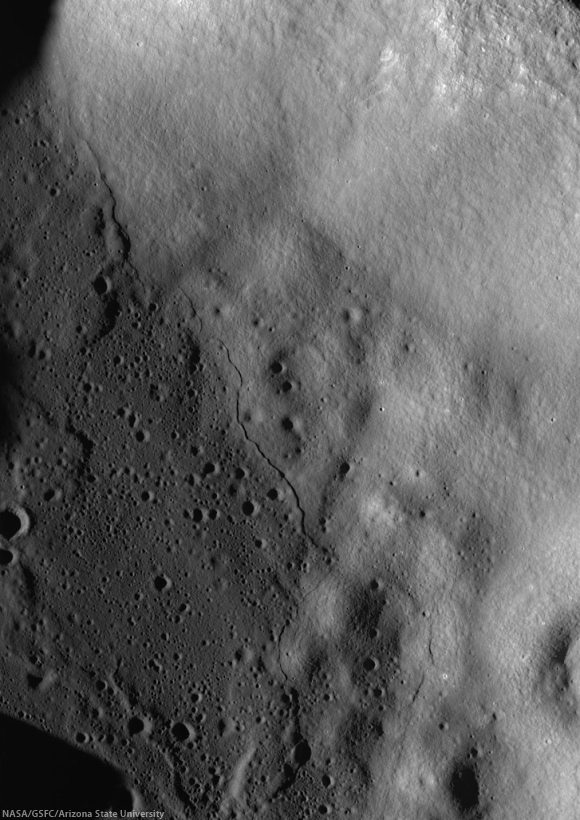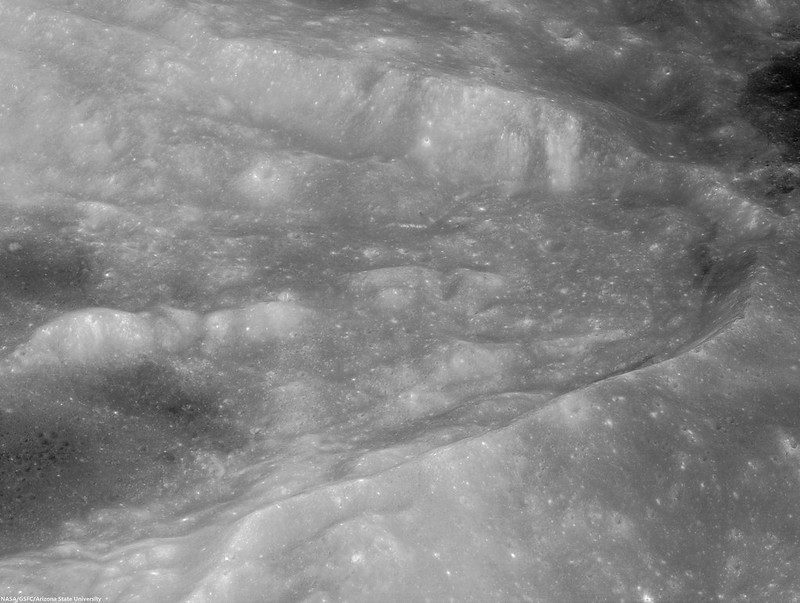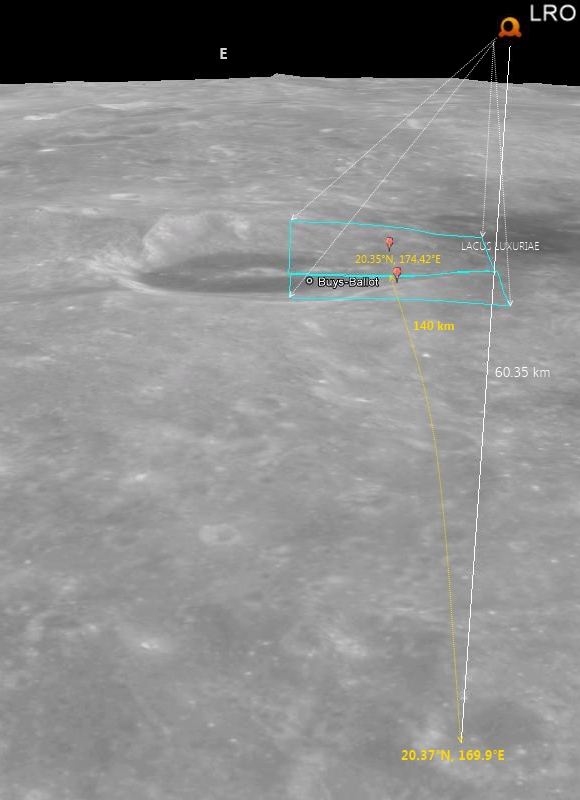 |
| LROC Featured Image, released December 5, 2013: Lobate scarp ridge along the east floor of Buys-Ballot crater. LROC NAC image centered on 21.321°N, 175.152°E, field of view 1.41 km. Sunset illumination (angle of incidence 82.35°), LROC NAC observation M1095343282LR, LRO orbit 13796, June 26, 2012; mean resolution 1.4 meters per pixel, spacecraft and camera slew 2.31° off nadir, captured from 139.75 km over 20.94°N, 175.0°E [NASA/GSFC/Arizona State University]. |
Hiroyuki Sato
LROC News System
The opening image is of the eastern edge of the floor of the farside crater Buys-Ballot (66.4 km in diameter). The shape of this crater is elongated from the northwest to southeast (see next WAC context image), likely due to a low impact angle. The floor is partially resurfaced by basaltic lava, leaving a relatively flat area around the linearly aligned central peaks.
The topographic ridge from upper-left to lower-right of the opening image is offset along a lobate scarp that extends about ~60 km along the contact of the flat floor and eastern crater wall. The late afternoon illumination from the left side of this image (incidence angle is 82.4°) highlights the fault scarp and the up thrown lava (lower left half of the image). The scarps extend out of the crater in the south, but segments there are not as well developed as those inside the crater and gradually disappear.
The lobate scarp is located in mare basalts and extends up and out of the crater into the surrounding highlands, somewhat similar to the famous Lee Lincoln scarp near the Apollo 17 landing site. Although formed in mare, the fault scarp does not have the distinctive morphology typical of wrinkle ridges that are found exclusively in mare basalts (see Wrinkles in Mare Frigoris, The Ghosts of Mare Fecunditatis & Boulder Clusters on a Ridge Crest).
Lobate scarps are formed by thrust faults caused by global contraction of the Moon as its interior cools. Sometimes these young thrust faults crosscut highland craters like Buys-Ballot crater and Seares crater, resulting in fascinating sharp morphologies on top of the featureless flat basaltic plain.
Explore the low-sun picture of the lobate scarps inside Buys-Ballot crater, HERE.
Related Posts:
Squished Crater
Taurus Littrow Valley, West-To-East
Not Your Average Scarp
Lobate Scarp or Fluidized Ejecta?
Tectonics in Mare Frigoris
Scarps in Schrödinger
Lunar Lobate Scarp
Right Angle
Slipher Crater: Fractured Moon in 3-D
Aitken Crater Constellation Program Region of Interest
The Moon in 3D
LROC News System
The opening image is of the eastern edge of the floor of the farside crater Buys-Ballot (66.4 km in diameter). The shape of this crater is elongated from the northwest to southeast (see next WAC context image), likely due to a low impact angle. The floor is partially resurfaced by basaltic lava, leaving a relatively flat area around the linearly aligned central peaks.
The topographic ridge from upper-left to lower-right of the opening image is offset along a lobate scarp that extends about ~60 km along the contact of the flat floor and eastern crater wall. The late afternoon illumination from the left side of this image (incidence angle is 82.4°) highlights the fault scarp and the up thrown lava (lower left half of the image). The scarps extend out of the crater in the south, but segments there are not as well developed as those inside the crater and gradually disappear.
 |
| Full 15.3 km-wide field of view centered on area shown at 1.41 meters per pixel resolution in the LROC Featured Image, above, released December 5, 2013. LROC NAC mosaic M1095343282LR [NASA/GSFC/Arizona State University]. |
Lobate scarps are formed by thrust faults caused by global contraction of the Moon as its interior cools. Sometimes these young thrust faults crosscut highland craters like Buys-Ballot crater and Seares crater, resulting in fascinating sharp morphologies on top of the featureless flat basaltic plain.
 |
| Context view of Buys-Ballot crater (LROC Wide Angle Camera monochrome mosaic, resolution standard global 100 meter per pixel), field of view centered on 20.86°N, 175.15°E. The LROC NAC mosaic footprint (blue rectangle) and location of LROC Featured Image (yellow arrow) noted [NASA/GSFC/Arizona State University]. |
Related Posts:
Squished Crater
Taurus Littrow Valley, West-To-East
Not Your Average Scarp
Lobate Scarp or Fluidized Ejecta?
Tectonics in Mare Frigoris
Scarps in Schrödinger
Lunar Lobate Scarp
Right Angle
Slipher Crater: Fractured Moon in 3-D
Aitken Crater Constellation Program Region of Interest
The Moon in 3D
 | |
| Bonus image: an oblique view of the south interior of the Buy-Ballot formation. LROC Narrow Angle Camera (NAC) mosaic M167091099LR, LRO orbit 9758, August 4, 2011; angle of incidence 58.6°, camera and spacecraft slew from nadir 64.7° - mean resolution 3.9 meters per pixel, from 60.35 km over 20.37°N, 169.9°E, 140 km east of field of view (mechanics of observation below) [NASA/GSFC/Arizona State University]. |
 |
| Mechanics of 'Bonus' image, above; highly slewed LROC NAC oblique observation M167091099LR, a slewed view of the southern interior of the Buys-Ballot formation [Google Earth]. |


No comments:
Post a Comment